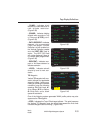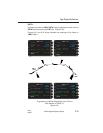
PLAN CROSSING:
System determined crossing
based on programmed con-
straints and flight path angles
for descent. (Figure 2-48)
This field is displayed for
other than the Active Vertical
Waypoint and will be dis-
played in place of EST
CROSSING.
OFFSET:
Pilot entered value in nautical miles (-99 to +99 range) where a posi-
tive entry (+) indicates an offset beyond the waypoint and a negative
(-) entry is prior to the waypoint.
NOTE: Pilot must enter the leading (+) sign for the offset to be
beyond the fix, but a (-) prefills as a default to cross prior to the fix.
REQ FPM (Required Feet Per Minute):
Required vertical speed in feet per minute the aircraft must maintain to
reach the Vertical waypoint. UP indicates a positive vertical speed
and DN indicates a negative vertical speed is required.
NOTE: If PLAN CROSSING is displayed, then the REQ FPM is the
planned vertical speed for the waypoint. REQ FPM will be dashes if
ground speed or air data is not valid.
FPA (Flight Path Angle):
Flight Path Angle for path descent to waypoint in degrees and tenths
with valid range 0.1 to 6.0. The following may appear in parentheses:
• DB: Indicates FPA from
database.
• MAN: Indicates manually
entered FPA.
• DIR: Indicates direct FPA
programmed. (Figure 2-49)
• AUTO: Indicates system
computed FPA.
Page Display Definitions
2-41
GNS-XL Flight Management System
Rev. 0
Oct/96
WAYPOINT VUZ
ALT FL180
EST CROSSING FL180
OFFSET ---
REQ FPM DN 825
FPA (AUTO) DN 3.0
DIRECT FPA DN 0.4
VNAV WAYPOINT 1/1
<
<
<
Figure 2-48
WAYPOINT ELD
ALT FL250
EST CROSSING FL254
OFFSET -5
REQ FPM DN 625
FPA (DIR) DN 2.3
DIRECT FPA DN 2.3
VNAV WAYPOINT 1/1
<
<
<
Figure 2-49


















